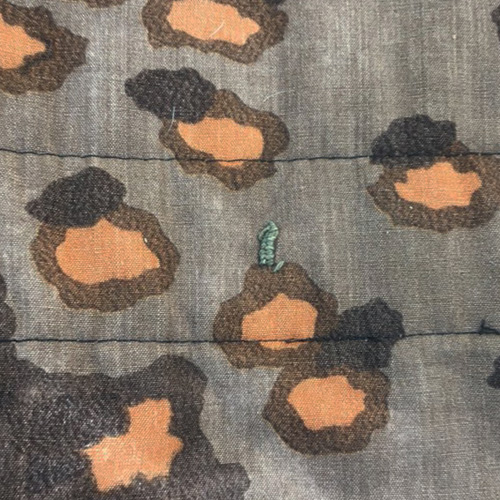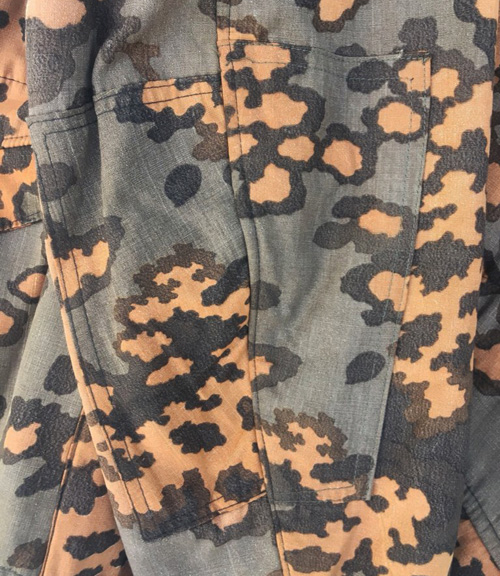How to choose the size?
The price is only for the jacket. Suitable pants are sold separately. See the recommended products at the bottom of the page. Apply the discount code WINTERCAMO in the shopping cart and buy complete pants at the same time as a jacket with a discount! Buy a jacket and pants at once to get a set. The color and material may change slightly with each new batch, you can't buy a part of the set in addition later, we will not be able to select the matching fabric!
In the product photo: size II (medium) is worn on a person who usually wears Russian size 52 or L, XL. Height 180 cm, chest 100 cm, shoulder width along the top 45 cm, girth 98 cm. The parka is worn over the summer set, as as it should be.
The size of the jacket fits the size of the pants, that is, the jacket and pants must be bought in the same size. If you wear a tunic of size M, then you need to buy a winter jacket M (that is, size I), you should not add the size "for the winter", everything has already been added. The standart height for the jackets and pants is 182 cm. This affects the length of the sleeves for jackets and the length of the legs for pants. German winter jackets were of three sizes: small, medium and large; we did the same. German winter jackets are made wide enough not to fetter a soldier and to fit different body-shapes; this must be understood if you are not buying a jacket for reenactment, but for civilian use.

Canadian soldiers in Merksem, Belgium (near Antwerp), seizing the unifroms warehouses of the factory Reitz. The terrain is flat, rugged by rivers, the weather is windy and cold: Canadians are insulated as they can. Pay attention to the ratio of length and width of German winter jackets. Photo source: National Archives of Canada and the book of V. Palinckx "Camouflage uniforms of the German Wehrmacht."
You can choose the size without trying. You will need a flexible meter or at least a rope. Measure a similar winter jacket that suits you. Designations:
• Chest around — the recommended bare chest girth for a given jacket size (taking into account that you will wear it over a sweater and tunic); in brackets there is the maximum girth of the chest, which will fit into a jacket of this size (without a sweater and tunic).
• Plain chest — of the jacket under the armpits when the waistband is completely loose.
• Sleeve length — from the shoulder seam down in a straight line.
• Back height — from the hood bottom stitch down in a straight line.
• Shoulder — from hood bottom to the sleeve seam.
• The width of the shoulders — between the sleeves' seams along the shoulder seams, behind the neck.
| Size of the parka | Russian, international size | Chest around | Plain chest | Sleeve length | Back height | Shoulder | The width of the shoulders |
| I | 48-50, S-M | up to 100 (110) | 66 | 60 | 75 | 17 | 53 |
| II | 52-54, L-XL | up to 110 (120) | 70 | 64 | 78 | 19 | 57 |
| III | 56-58, 2XL-3XL | up to 120 (130) | 74 | 68 | 81 | 21 | 62 |
You can choose the size that is in stock. If the required size cannot be selected, then it is (already) out of stock.
Description
The parka is sewn from dense natural fabric with linen weaving (cotton duck, such as a tent). Such fabric protects from wind and water the best. Below is a video about fabric printed exclusively for our shop in October 2019.
The camouflage pattern is carefully copied: this is the work of of our Replika shop team. The color scheme is taken from the original costume presented in the book L. Silvestri "Waffen-SS camouflage uniforms", volume 2, pages 774-792. The fabric was made exclusively for our Replika shop and used for our winter jackets; it is not sold anywhere except replik.ru. It should be noted that we used 2 different rolls of camouflage, which are slightly different in color and contain different print defects. This is done specifically to repeat the original, which is also assembled from pieces. At the end of the war, the savings were tough, and scraps of fabric from previous runs of clothes used for small parts. Sometimes even large parts were from different lots (for example, front and back jackets or pants).

Original winter jacket in Oak camo, made from different shades of the same camouflage.
The same applies to the white side of the jacket: it is tailored from pieces of white fabric that are slightly different in color. Inside the insulation from recycled clothing is used, as it was in the originals. The Germans collected the old uniforms, as well as civilian clothes (including trophy and confiscated) and recycled it, getting a cloth like a loose blanket. The composition of such insulation varied due to the heterogeneity of the raw materials. In general, winter suits were not very warm. They had to be worn over a shirt, a cloth uniform and a sweater (a multilayer military uniform system is used to date). In a full suit, it is comfortable down to -15 degrees Celsius, however, this is not enough for guard duty (long inactivity), for this there were a special overcoat and guard boots.
We were attentive to the details, found and copied even insignificant and inconspicuous at first glance.
Button loops have a round end (eyelet) and a perpendicular limiting seam (lock) at the other end. Not expensive copies have loops with a wedge-shaped end, because this is the norm for modern equipment, and the Germans did not use them in the mid-1940s (extremely rarely on clothes 1944-1945).
Original Oak winter jacket, view to the base of the sleeve and armpit reinforcement. The same part is photographed on our product (among other product photos at the top of the page). Photo of the original jacket: Volchkov A.
A special double-sided tape was usually used for the waistband and cuffs (on one side pale green, on the other white). Another option was to sew belt from two colors of fabric (like a jacket), however, this was done only on the very first models (plain pale green). The tape was cheap in production and allowed to save fabric and time for assembly of these small elements. The ends of the tape are usually tucked straight 2 times (at the latest only 1 time, securing with a zigzag line along the cut so that it does not fluff). Only on the very first (plain colour) winter jackets did the ends fold into a triangle. Some manufacturers of modern copies make a mistake with the tips of these tapes.

Original waistband on a winter jacket SS. The end is tucked 1 time and stitched by cut. The source of the photo of the original item: lux-military-antiques.com
The cords and waistband of SS jackets are often sewn in the back in the middle (on the camouflage side) with a simple thread by hand. This is done so that they can not be accidentally pulled out, and do not warp. This was not always met and, apparently, depends on the producer or the batch.



The place for sewing of the waistband on different original SS winter jackets is in the middle of the back. Original photo source: lux-military-antiques.com и др.
Winter sets were fastened on metal grain buttons (standard for the German uniforms). However, glass and plastic buttons (flat with 4 holes) were often found. This was due to the development of the German chemical industry, which complied with the development of new, cheap and durable materials. Flat buttons were more convenient than metal buttons on a leg, although they didn’t look so beautiful. Sometimes the buttons were made of pressed cardboard, they have a recognizable design with small corrugations in a circle. Similar original jackets have a different set of accessories.





Types of original buttons on SS winter jackets (not a complete list). Original photo source: lux-military-antiques.com, Anton Volchkov and others.
There are reinforcements on the elbows of the jacket. Also, the hood has 4 tucks at the top to more densely cover the head in front. These features appeared together with camouflage models of jackets (they are not found in plain ones) no earlier than the winter of 1943/44. Moreover, the features of tailoring are not tied to the color of the jacket, but to the time of its manufacture. The original winter suits in camouflage Oak Spring (green shades of spots) were sewn both according to the early and late patterns.


Reinforcement on elbows and tucks on the hood of the original winter jackets. Elbow reinforcements do not always fit together, it depended on the manufacturer and the production time.
The pockets of SS winter jackets were 5-point (unlike 4-point in the Heer). The shape of the valve of the pockets was complex, the valve seemed to “flow down” (so the upper part of the valve was longer than the lower). But the buttonhole, on the contrary, was not vertical, but inclined.


Pocket valves on original SS winter jackets. Please note that there is a jacket in “Blurred Edge” camouflage in the photo on the left, and the valve is made of “Oak-B” camouflage.
How to care for the product?
The soldiers at the front did not have the opportunity to wash their jackets (especially in the washing machine). After the winter (or in the case of taking the unit to rest in the deep rear), they handed the winter uniform over, and the rear services cleaned, sorted and stored it. Therefore, washing the winter uniform in the washing machine is an extreme measure. To get started, you just need to wash the jacket with a sponge or a soft brush with soap or detergent for natural fabrics in those places where it is dirty (usually this is the neck and cuffs). You can wash off the detergent with a jet of water (shower in the bathroom, for example).
The use of bleach (stain remover) is permissible only manually on the white side and on a dry jacket. So you can return the whiteness to the cuffs and other dirty areas. However, if bleach seeps onto the camouflage side (for example, through a seam), white spots will forever remain. It is unacceptable to wash the entire jacket in bleach!
Washing a jacket is the removal of contaminants from external surfaces; inside the jacket there is nothing to wash. If you decide to save time and wash in a machine, then select the delicate washing mode at a temperature of no higher than 40 degrees. The jacket will not deteriorate, the color will not fade, however, the jacket will slightly lose its shape and will no longer look like new.



































